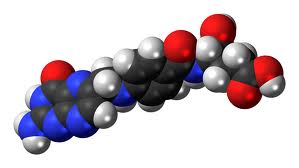Without it, no cell can divide. It prevents birth defects like spina bifida. It reduces our risk of cancer, heart disease and Alzheimer’s disease. It supports our immune system and fuels our mitochondria to give us energy.
Yet, despite having eight EFSA-approved health claims to its name, this humble vitamin can also be too much of a good thing; there’s growing evidence that overdosing can increase our cancer risk. Welcome to the double-edged sword of folate, or to be more correct, folic acid.
Cancer protector or creator?
A recent rat study by Canadian researchers published in PLoS ONE (2014: 9(1): e84635) revealed a little more about folic acid’s complex workings. They found that if malignancies in Sprague-Dawley rats had already been initiated, then supplementing with high doses of synthetic folic acid was tumour-promoting.
This brings us to the big bug-bear with many of the intervention studies, not only with folic acid, but also those with beta-carotene, vitamin E, vitamin A, selenium and other synthetic or highly purified vitamins; did the subjects have pre-existing, even pre-clinical, disease before the intervention started? Very often, this is not known. Where it is known, such as with the smokers or asbestos workers targeted with beta-carotene in the ATBC (N Engl J Med 1994; 330:1029-1035) and CARET (N Engl J Med 1996; 334:1150-1155) trials, it is now thought to be a major contributory factor.
This notion of promotion or suppression by a given nutrient is central to a raft of nutritional research. It was exactly what the Cambridge, Oxford, Imperial College and Harvard researchers were looking at in their systematic review and meta-analysis of fats published last week in the Annals of Internal Medicine (2014; 160(6): 398-406). As the media headlines reminded us, the relationships are complex and cannot be easily generalised. So much so, in fact, that saying saturated fats are bad for you — something health authorities have been telling us for decades — is now bunkum. But, equally, saying they’re always good for you, may be equally nonsensical.

Dietary vs synthetic forms
Let’s get back to folate. Observational studies have led us to believe that people who eat more folate in their diets — in the form of leafy green vegetables, legumes and oranges, for example — benefit from the positive side of folate’s sword. They get to reduce their risk of cancer and heart disease which sounds like a huge benefit given these are the two top killers in modern society. As with beta-carotene and vitamin E before it, such findings stimulated large-scale intervention studies using supplemental forms of the vitamins. Folic acid, like with many other vitamin forms used in supplements, occurs rarely in nature and the stuff used in supplements and fortified foods is made synthetically.
But even before we had a more complete understanding of folate’s key role in human health, folic acid was long — and rightly — seen as a vitamin with one of the most thoroughly proven benefits. This evidence was of course responsible for the EU’s eight authorised health claims and the FDA’s qualified health claim for 800 mcg aimed at protecting babies from neural tube defects.
Vitamin forms used in supplements have in the main been created by pharmaceutical companies to give rise to stable compounds that it is hoped behave in a manner that’s comparable to the real thing. They must after all be able to sit on a pharmacy, supermarket or health store shelf for a couple of years or more without significantly deteriorating. Natural folate, especially in its active form, 5’-methyltetrahydrofolate (5-MTHF), is famously unstable. It might be found in significant quantities along with the formyltetrahydrofolate form (FTHF), tetrahydrofolate and dihydrofolate in spinach and other leafy greens, but cook it for any period of time – and most will be gone. Stability, not performance, has therefore been the primary driver for making synthetic folic acid the choice in most supplements and fortified foods.
Genetic polymorphisms
The more we learn about genetic mutations (polymorphisms) of genes responsible for producing these (and other) enzymes, the more we recognise the problem of delivering nutrient forms that are at odds with those in our diets. This is especially the case with diseased populations, who, it turns out, may be more susceptible to the given disease, be it cancer, heart disease or autism, because of their individual suite of genetic polymorphisms.
The most comprehensive meta-analysis on folic acid intervention studies to date was published last year in The Lancet (2013; 381 (9871): 1029-1036). It’s not the overwhelmingly bad news for folic acid it could have been. After examining data on 50,000 subjects from 13 trials, the researchers from Oxford University concluded that there was no statistically significantly increased – or decreased – risk of colorectal, lung, breast or prostate cancer among folic acid supplemented groups.
What the researchers did find was, however, somewhat disturbing: a weak, statistically non-significant 6% greater cancer risk overall among those supplementing with the synthetic form of the vitamin, compared with non-supplementing subjects. But, interestingly, those who took the highest doses didn’t appear to be at any greater risk. Nor was there any suggestion that those who supplemented for longer periods were more likely to get cancer.
Russian roulette?
None of this should detract from the observational and epidemiological evidence which remains strongly in favour of getting plenty of folate in the diet. So, is it the high doses of the synthetic form or its isolated nature – when separated from the food matrix – that makes it spikier to our metabolism? Or is it that some of us can’t metabolise the synthetic form properly because of our unique genetics? Presently, it seems, we just can’t be sure, and it’s quite possible that in some people all of these factors might play a role.
UMFA: the new ‘bad guy’
What’s also beginning to emerge is that a build up of unmetabolised synthetic folic acid, or UMFA, in the bloodstream presents a health risk. US researchers have estimated that about 40% of the US population suffer this condition given folic acid is now so widely distributed in supplements and fortified foods; unsurprisingly, they are concerned that it may promote cancer (Am J Clin Nutr, 2010, 92 (2), 383-389). Herein lies the dark side of the golden vitamin. Folic acid, a vitamin long upheld as one of the most important to our health, being capable of reducing risk factors for several diverse and very important diseases, now reveals itself as an ‘emerging’ risk factor for cancer.
As the complex interface of epigenetics, evolutionary biology and folate trafficking comes into sharper focus, this shouldn’t perhaps be as much of a surprise as it might initially seem. Through our evolution, our bodies have learned to use nutrients in highly complex control and feedback processes that are at odds with typical pharmacological kinetics. For these natural systems to work, the right substrates, as well as the right environment and gene expression, are needed. And this is the domain of the so-called low bioavailability, unstable folates found in foods. Sometimes we’re perhaps too quick to assume that Nature has made a mistake in providing us with a nutrient that is intrinsically unstable or less bioavailable than its test tube counterpart.

Go for the real thing
When it comes to creating bioactive 5-MTHF at the right time, in the right cells of the body, a great deal of research has elucidated the workings of one of the key genes involved with folate metabolism, methylene tetrahydrofolate reductase (MTHFR). But this enzyme is a team player. When it comes to folic acid, which requires more metabolic conversion steps to yield 5-MTHF than the dietary folates, there are actually 9 genes and 15 different enzymes involved in its staged reduction to the active 5-MTHF form. While we are learning more about another enzyme, dihydrofolate reductase, there are still huge data gaps in our knowledge of how different combinations of polymorphisms might impact our ability to use folic acid.
To get over uncertainties in how your body metabolises folic acid and eliminate the problem of UMFA, you can of course take a stabilised, reduced form of 5-MTHF. For this purpose, Merck offers the calcium salt of 5-MTHF (Metafolin), while the Italian company Gnosis now produces a glucosamine bound form (Quadrefolic).
FDA wants to say goodbye to folate
When you read the FDA’s latest proposed rule on food and dietary supplement labelling, one wonders why the Agency wants to do away with the term ‘folate’ and leave ‘folic acid’ —along with its double-edge sword—as the only allowable term for folate on dietary supplement labels. Folic acid is of course a different beast, an oxidised, monoglutamyl one at that, compared with the polyglutamyl dietary folates and reduced supplemental forms. And presumably the FDA wouldn’t want consumers to be misled? And isn’t it accepted that ‘folate’ is the name given to the B9 vitamin group, and that folic acid and calcium methylfolate, for example, are forms thereof?
This begs the question: Is the FDA prepared for the term ‘folic acid’ to be used as a misnomer for the Merck and Gnosis reduced forms — or has it got something else up its sleeve? Is it just possible that the plan is to leave common and garden synthetic folic acid as the sole, allowable form for the dietary supplement industry, while pharma gets to play with the reduced forms for medical foods and drug cocktails?
Will you offer your opinion to the FDA?
Comments on the FDA’s consultation for the proposed rule close on 2 June this year. If there appears no desire by the FDA to change its text, it may well be that its game plan will have been unwittingly laid bare.
Click here for more information from ANH-I.
